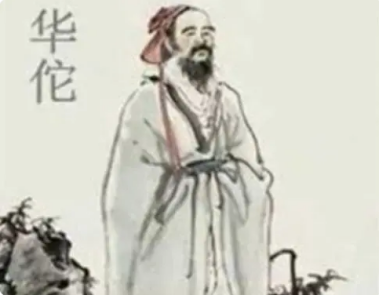
Chinese doctors in the early periods didn’t spend much time on surgery. They felt that surgery was a matter of last resort. If surgery was needed, a less experienced doctor carried it out. But around the beginning of the 3rd century CE, a surgeon named Hua Tuo started to change Chinese surgery.
Hua Tuo was a famous physician during the Eastern Han Dynasty and Three Kingdoms era of China. He engaged in a wide variety of surgeries. The Book of Later Han records Hua Tuo as the inventor of mafeisan. Surgery was Hua Tuo’s main interest, but he also worked on other things. His exercises called “Wu Qin Xi”, where patients copied movements of a tiger, deer, bear, ape, and crane to enhance health, became very popular.
The end of Hua Tuo’s life is unclear because there are many conflicting stories. One possible story is that he became the court physician for Cao Cao, the king of Wei, late in his life. Cao Cao had bad headaches, and Hua Tuo used acupuncture (针灸) to help him stop the pain. Later, as Cao Cao’s pain got worse and needed long treatment, Hua Tuo came to treat Cao Cao exclusively. After being away from home for a long time, Hua Tuo wanted to go home for a short time, and Cao Cao agreed. When Hua Tuo got home, he delayed going back to Cao Cao and said his wife was sick. Cao Cao sent many letters asking him to return. But Hua Tuo delayed leaving. Cao Cao sent people to check if Hua Tuo’s wife was really sick. If not, Hua Tuo would be arrested. Finally, Hua Tuo was put in jail and was killed.
Legend has it that Hua Tuo gave his Qing Nang Shu, which recorded techniques for treating patients, to a prison official. However, this official, burned the book. Many of Hua Tuo’s medical methods were lost forever. This was a big loss for traditional Chinese medicine.
原创编写 版权所有 侵权必究! 每日更新 个性化阅读 英语飙升!
1.1. What can be inferred about “Wu Qin Xi”?
A It was used to treat headaches.
B It was designed to improve physical health.
C It was only performed by experienced doctors.
D It was a form of surgery.
解析:选B。细节理解题。根据第二段的“His exercises called “Wu Qin Xi”, where patients copied movements of a tiger, deer, bear, ape, and crane to enhance health, became very popular.”可推知,五禽戏是模仿熊、虎、猿、鹿、鹤这五种动物的动作与神态,从而创造出的一种运动方式,旨在改善身体健康。故选B。
2.2. What was the possible reason for Hua Tuo’s arrest and death?
A He was caught lying about his wife’s illness.
B He refused to treat Cao Cao’s headaches directly.
C He was unable to cure Cao Cao’s headaches.
D He was accused of stealing medical secrets.
解析:选A。细节理解题。根据第三段的“Cao Cao sent people to check if Hua Tuo’s wife was really sick. If not, Hua Tuo would be arrested. Finally, Hua Tuo was put in jail and was killed.”可知,华佗因为被揭穿关于妻子病情的谎言而被曹操逮捕并最终被处死。故选A。
3.3. What happened to Hua Tuo’s written medical book?
A It was carefully preserved.
B It was widely spread.
C It was destroyed.
D It was translated into many languages.
解析:选C。细节理解题。根据最后一段“However, this official, burned the book.”可知,华佗的医书被烧毁了。故选C。
4.4. What is the main idea of the passage?
A The history of acupuncture in China.
B Hua Tuo’s hobby and its impact on medicine.
C The importance of traditional Chinese medicine.
D The life and contributions of Hua Tuo.
解析:选D。主旨大意题。本文主要讲述了华佗的生平和他对中医学所作出的贡献。故选D。